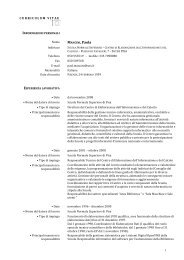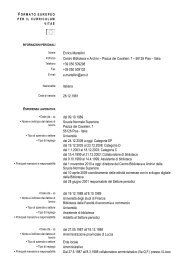7.3 L 1 metric <strong>and</strong> Plateau problemIf we wish to def<strong>in</strong>e a geometric norm on T c M that is modeled on the norm <strong>of</strong>the Banach space L 1 (S 1 → lR N ), we may def<strong>in</strong>e the metric∫F 1 (c, h) = ‖π N h‖ L 1 = |π N h(θ)||c ′ (θ)|dθ ;the length <strong>of</strong> a homotopy is then∫∫Len(C) = |π N ∂ t C(t, θ)||C ′ (t, θ)| dt dθwhich co<strong>in</strong>cides with∫∫Len(C) =|∂ t C(t, θ) × ∂ θ C(t, θ)| dθ dtThis last is easily recognizable as the surface area <strong>of</strong> the homotopy (up tomultiplicity); the problem <strong>of</strong> f<strong>in</strong>d<strong>in</strong>g a m<strong>in</strong>imal geodesic connect<strong>in</strong>g c 0 <strong>and</strong> c 1 <strong>in</strong>the F 1 metric may be reconducted to the Plateau problem <strong>of</strong> f<strong>in</strong>d<strong>in</strong>g a surfacewhich is an immersion <strong>of</strong> I = S 1 × [0, 1] <strong>and</strong> which has fixed borders to the<strong>curves</strong> c 0 <strong>and</strong> c 1 . The Plateau problem is a wide <strong>and</strong> well studied subject uponwhich Fomenko expounds <strong>in</strong> the monograph [20].8 Riemannian metrics <strong>of</strong> <strong>curves</strong> up to poseA particular approach to the study <strong>of</strong> <strong>shape</strong>s is to def<strong>in</strong>e a <strong>shape</strong> to be a curve upto reparameterization, rotation, translation, scal<strong>in</strong>g; to abbreviate, we call thisthe <strong>shape</strong> space <strong>of</strong> <strong>curves</strong> up to pose. We present two examples <strong>of</strong> Riemannianmetrics.8.1 Shape Representation us<strong>in</strong>g direction functionsKlassen, Mio, Srivastava et al <strong>in</strong> [28, 41] represent a planar curve c by a pair <strong>of</strong>velocity-angle functions (φ, α) through the identityc ′ (u) = exp(φ(u) + iα(u))(identify<strong>in</strong>g lR 2 = IC), <strong>and</strong> then def<strong>in</strong><strong>in</strong>g a metric on the velocity-angle functionspace. They propose models <strong>of</strong> spaces <strong>of</strong> <strong>curves</strong> where the metrics <strong>in</strong>volve higherorder derivatives <strong>in</strong> [28].We review here the simplest such model, where φ = 0. We consider <strong>in</strong> thefollow<strong>in</strong>g planar <strong>curves</strong> ξ : S 1 → lR 2 <strong>of</strong> length 2π <strong>and</strong> parameterized by arclength. (Note that such <strong>curves</strong> are automatically Lipschitz cont<strong>in</strong>uous).Proposition 8.1 (Cont<strong>in</strong>uous lift<strong>in</strong>g, w<strong>in</strong>d<strong>in</strong>g number) If ξ ∈ C 1 <strong>and</strong> parameterizedby arc parameter, then ξ ′ is cont<strong>in</strong>uous <strong>and</strong> |ξ ′ | = 1, so there existsa cont<strong>in</strong>uous function α : lR → lR satisfy<strong>in</strong>gξ ′ (s) = ( cos(α(s)), s<strong>in</strong>(α(s)) ) (8.1)52
130−2Figure 10: Examples <strong>of</strong> <strong>curves</strong> <strong>of</strong> different w<strong>in</strong>d<strong>in</strong>g number.<strong>and</strong> α(s) is unique, up to add<strong>in</strong>g the constant k2π with k ∈ Z.Moreover α(s + 2π) − α(s) = 2πI, where I is an <strong>in</strong>teger, known as w<strong>in</strong>d<strong>in</strong>gnumber, or rotation <strong>in</strong>dex <strong>of</strong> ξ. This number is unaltered if ξ is homotopicallydeformed <strong>in</strong> a smooth way.See the examples <strong>in</strong> Fig. 10.The addition <strong>of</strong> a real constant to α(s) is equivalent to a rotation <strong>of</strong> ξ. Wethen underst<strong>and</strong> that we may represent arc parameterized <strong>curves</strong> ξ(s), up totranslation, scal<strong>in</strong>g, <strong>and</strong> rotations, by consider<strong>in</strong>g a suitable class <strong>of</strong> lift<strong>in</strong>gs α(s)for s ∈ [0, 2π].Two spaces are def<strong>in</strong>ed <strong>in</strong> Klassen et al. [28]; we present the case <strong>of</strong> “ShapeRepresentation us<strong>in</strong>g Direction Functions”;Def<strong>in</strong>ition 8.2 let L 2 := L 2 ([0, 2π] → lR); Φ : L 2 → lR 3 is def<strong>in</strong>ed byΦ 1 (α) :=∫ 2π0α(s) ds , Φ 2 (α) :=∫ 2π0cos α(s) ds , Φ 3 (α) :=∫ 2π<strong>and</strong> the space <strong>of</strong> (pre)-<strong>shape</strong>s is def<strong>in</strong>ed as the closed subset S <strong>of</strong> L 2 ,S := { α ∈ L 2 | Φ(α) = (2π 2 , 0, 0) } ;0s<strong>in</strong> α(s) ds .the condition Φ 1 (α) = 2π 2 forces a choice <strong>of</strong> rotation, while Φ 2 = 0, Φ 3 = 0ensure that α represents a closed curve.For any α ∈ S, it is possible to reconstruct the curve by <strong>in</strong>tegrat<strong>in</strong>gξ(s) =∫ s0(cos(α(t)), s<strong>in</strong>(α(t)))dt (8.2)This means that α identifies an unique curve (<strong>of</strong> length 2π, <strong>and</strong> arc parameterized)up to rotations <strong>and</strong> translations, <strong>and</strong> to the choice <strong>of</strong> the base po<strong>in</strong>t ξ(0); forthis last reason, S is called <strong>in</strong> [28] a pre<strong>shape</strong> space.Inside the family <strong>of</strong> arc parameterized <strong>curves</strong>, the reparameterization 11 <strong>of</strong> ξis restricted to the transformation ˆξ(u) = ξ(u − s 0 ), that is a different choice <strong>of</strong>base po<strong>in</strong>t for the parameterization along the curve. Inside the pre<strong>shape</strong> spaceS, the same operation is encoded by the relation ˆα(s) = α(s − s 0 ).To obta<strong>in</strong> a model <strong>of</strong> immersed <strong>curves</strong> up to reparameterization, rotation,translation, scal<strong>in</strong>g we need to quotient S by the relation α ∼ ˆα, for all possibles 0 ∈ lR. We do not discuss this quotient here.We now prove that S \ Z is a smooth manifold. We first def<strong>in</strong>e Z.11 We are consider<strong>in</strong>g only reparameterizations <strong>in</strong> Diff + (S 1 ).53
- Page 1 and 2: Metrics of curves in shape optimiza
- Page 3 and 4: shape analysis where we study a fam
- Page 5 and 6: • F (c) = F (c ◦ φ) for all cu
- Page 7 and 8: κ > 0HNNHNHκ < 0Figure 1: Example
- Page 9 and 10: In the case of planar curves c 1 ,
- Page 11 and 12: (a) (b) (c) (d) (e)Figure 3: Segmen
- Page 13 and 14: where φ may be chosen to beφ(x) =
- Page 15 and 16: 2.4.1 Example: geometric heat flowW
- Page 17 and 18: 2.4.5 Centroid energyWe will now pr
- Page 20 and 21: shapes. Unfortunately, H 0 does not
- Page 22 and 23: • If the second request is waived
- Page 24 and 25: • The Fréchet space of smooth fu
- Page 26 and 27: Since φ k are homeomorphisms, then
- Page 28 and 29: 3.6.1 Riemann metric, lengthDefinit
- Page 30 and 31: Theorem 3.30 Suppose that M is a sm
- Page 32 and 33: Example 3.38 Let M = C ∞ ([−1,
- Page 34 and 35: • sometimes S 1 will be identifie
- Page 36 and 37: The proof is by direct computation.
- Page 38 and 39: The term preshape space is sometime
- Page 40 and 41: 5 Representation/embedding/quotient
- Page 42 and 43: 6.1.1 Length induced by a distanceI
- Page 44 and 45: 0101200000000000011111111111110000
- Page 46 and 47: 6.2.4 Applications in computer visi
- Page 48 and 49: of a small ball from A. The motion
- Page 50 and 51: CutΩ(The arrows represent the dist
- Page 54 and 55: Definition 8.3 (Flat curves) Let Z
- Page 56 and 57: Proof. Fix α 0 ∈ S \ Z. Let T =
- Page 58 and 59: 8.2.2 RepresentationThe Stiefel man
- Page 60 and 61: 9.3 Conformal metricsYezzi and Menn
- Page 62 and 63: 10.1.1 Related worksA family of met
- Page 64 and 65: Definition 10.7 (Convolution) A arc
- Page 66 and 67: and̂∇˜HjE(0) = ̂∇ H 0E(0),̂
- Page 68 and 69: and we simply integrate twice! More
- Page 70 and 71: Corollary 10.18 In particular, the
- Page 72 and 73: 10.6 Existence of gradient flowsWe
- Page 74 and 75: • The length functional (from C 1
- Page 76 and 77: We can eventually estimate the diff
- Page 78 and 79: 7.552.5-10 -7.5 -5 -2.5 2.5 5 7.5 1
- Page 80 and 81: By using (i) and (ii) from lemma 10
- Page 82 and 83: 10.6.3 Existence of flow for geodes
- Page 84 and 85: 10.7.1 Robustness w.r.to local mini
- Page 86 and 87: We already presented all the calcul
- Page 88 and 89: 10.9 New regularization methodsTypi
- Page 90 and 91: can be solved for k (this is not so
- Page 92 and 93: 2. Now• at t = 1/2 it achieves th
- Page 94 and 95: Definition 11.10 • The orbit is O
- Page 96 and 97: y eqn. (11.3), where the terms RHS
- Page 98 and 99: So Prop. 11.19 guarantees that the
- Page 100 and 101: Theorem 11.23 Suppose that the Riem
- Page 102 and 103:
2.2.3 Examples of geometric energy
- Page 104 and 105:
9 Riemannian metrics of immersed cu
- Page 106 and 107:
contour continuation, 11convolution
- Page 108 and 109:
normal vector, 6objective function,
- Page 110 and 111:
References[1] Luigi Ambrosio, Giuse
- Page 112 and 113:
[30] Serge Lang. Fundamentals of di
- Page 114 and 115:
[57] Ganesh Sundaramoorthi, Anthony




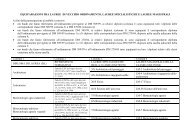
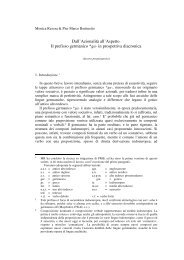
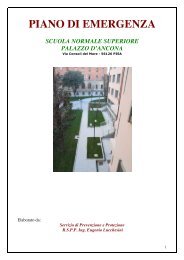
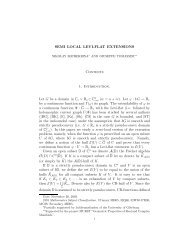
![4. Ghost [Å] vowels in French - Laboratorio di Linguistica](https://img.yumpu.com/49999334/1/184x260/4-ghost-a-vowels-in-french-laboratorio-di-linguistica.jpg?quality=85)



